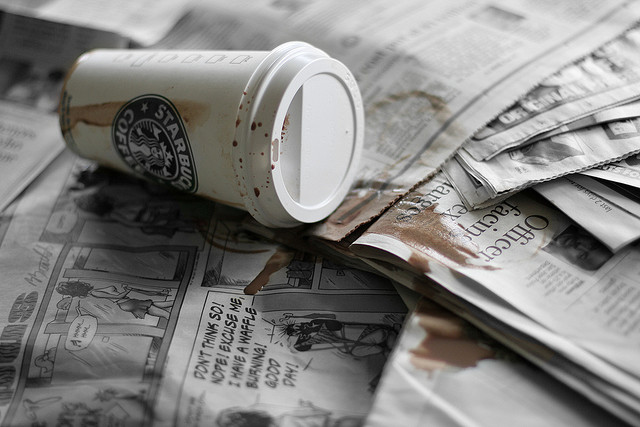We live in a world where everything is fast-paced, including our daily trips to get coffee in the morning.
In a matter of minutes, we stand in line, order our coffees in a take-away cup, and get out. We’re even bothered by the line that we have to wait in, and want our coffees made in one minute flat. We don’t have time to sit and drink a coffee—we’re already running late as it is.
We run on auto-pilot with a million thoughts running through our minds. So naturally, it makes sense that we wouldn’t take a moment to consciously ask ourselves, “Where does my cup go after I finish my coffee?” I know I didn’t.
“The coffee cup problem” is a real thing.
It’s a common misconception to think that we are doing good by the environment by using paper cups, like the ones most take-away coffee shops offer. They might even say biodegradable or compostable to trick us into thinking that we are doing the world a favor by using their cup.
It is misleading.
Most people, including me, think that paper cups are what they say they are—made out of paper. But in fact, to prevent any leaks or spills from seeping through the cups, they are lined with plastic, which sends these cups to the landfills. Contrary to popular belief, they don’t fully degrade, and are part of a huge problem with plastic waste and pollution.
Yes, the paper might break down. However, the plastic does not and can end up washed up on the shores at the beach, floating next to you while you’re paddling out to surf, or in the stomachs of marine life. It’s no secret how many dead animals are found to have large amounts of plastic trash in their stomachs.
Paper cups produce the second highest amount of plastic waste behind plastic bottles.
A busy coffee shop on average might use 500 paper cups a day. Imagine how much that adds up over the whole year.
Not only is the waste from paper cups ending up in our landfills and our oceans, the process of making paper is a dirty one. It involves chopping down forests, using absurdly large amounts of water, and a high consumption of fuel to transport. Turning the trees into wood chips, adding in chemicals to the mix, and then washing them multiple times is not sustainable or environmentally friendly.
According to New York Magazine, “…water, as every environmentalist can tell you, is the next petroleum, a great resource over which people will eventually go to war.”
Why does this matter?
Our oceans have become our trash bin, and plastic in the oceans is the world’s biggest global pollution problem.
According to the National Oceanic and Atmospheric Administration, approximately 1.4 billion pounds of trash enter the ocean per year. Heard about the North Pacific Gyre? It’s an island of trash twice the size of Texas floating out in the middle of the Pacific Ocean, off the coast of California. The pieces of plastic outnumber the total marine life six to one. Thousands of marine animals die per year, and plastic particles sneak their way into the animals we consume from the ocean as well. So not only are the animals getting sick from plastic, but by consuming them, so are we.
Governments around the world are noticing the serious consequences and starting to take this seriously. For example, many cities are banning plastic bags, which is a great step forward.
We don’t have to sacrifice our love of coffee to save the environment. There are a few very simple fixes that we can make to help keep our planet clean and save some trees.
Awareness. Start to keep track of how many cups, and plastic bottles too, for that matter, you are using in a day. “Okay, I bought a coffee this morning, got a take-away smoothie at lunch, forgot my water bottle in the car so bought another bottle…” It might amaze you how much plastic can be consumed in just one day. It adds up fast!
Just take one. If you are using single-use disposable cups, stick to just one cup. No need to double up. You can also ask for the drink to go without the lid. If you need to stir in your sugar, use one of their spoons instead of plastic cutlery or stir sticks. Most people would be more than happy to oblige. Try and avoid straws as much as possible. They’re unnecessary.
Bring your own cup. The price you pay for a ceramic mug, glass, or stainless steel cup pays for itself in just a few coffees. I’ve never walked into a coffee shop where I was told they could not use my cup. Some places even give you a discount on your coffee to thank you!
Sit and Drink it. If you forgot your mug, have your coffee there! You can actually sit for a couple minutes, taking the time to really taste and enjoy your coffee instead of multi-tasking or drinking it cold.
If you already are practicing all these suggestions, you can also start bringing your own glass takeout containers for your leftover food when you go out. Throw in some cutlery in a reusable bag while you’re at it, instead of using plastic cutlery that may be provided.
This might seem like a small part of the bigger picture, and it’s important to keep it in perspective. But it’s also important to remember to do what you can. Yes, we’ll forget our mugs at home sometimes, and when traveling it can feel almost impossible to avoid take away cups at the airport.
It might take more effort and time to make it a habit, like anything. When we are in a hurry, probably the last thing on our minds is the global or environmental impact of our little coffee cup. So making a simple habit change can help keep you on track.
I believe that starting small, just with your coffee cup, can bring change into your mornings and eventually lead to bigger and greater things.
~
Author: Tatiana Hall
Image: Eric/Flickr
Volunteer Editor: Pavita Singh / Editor: Catherine Monkman











Read 1 comment and reply